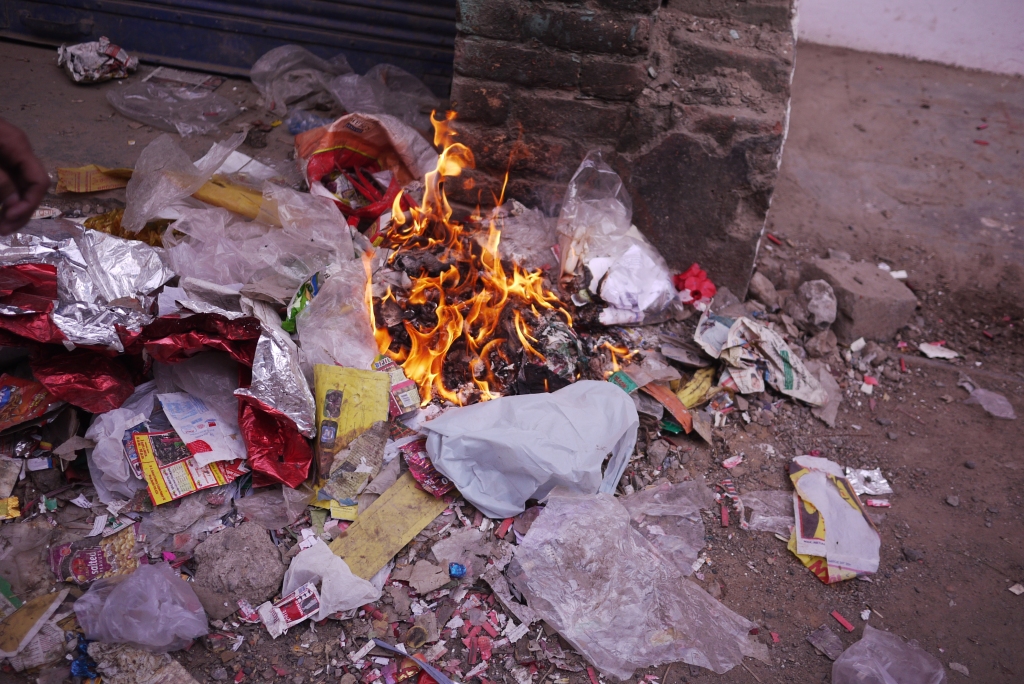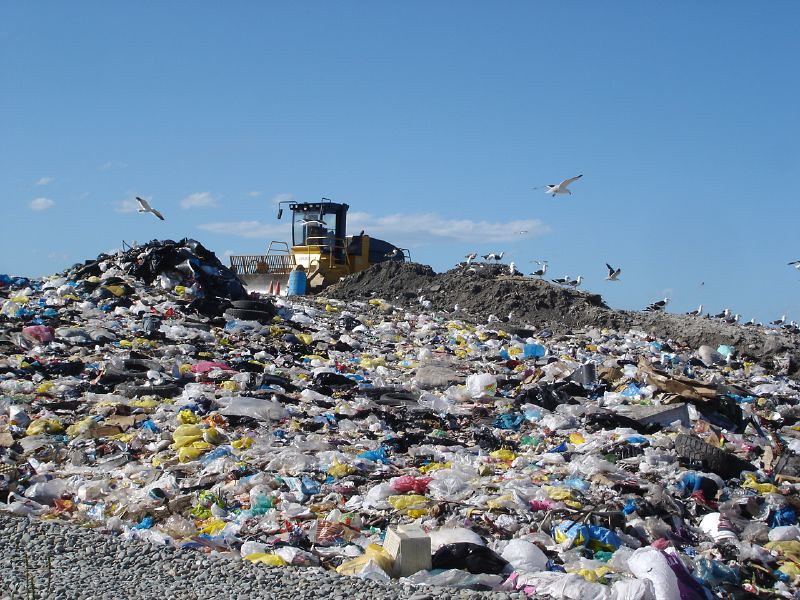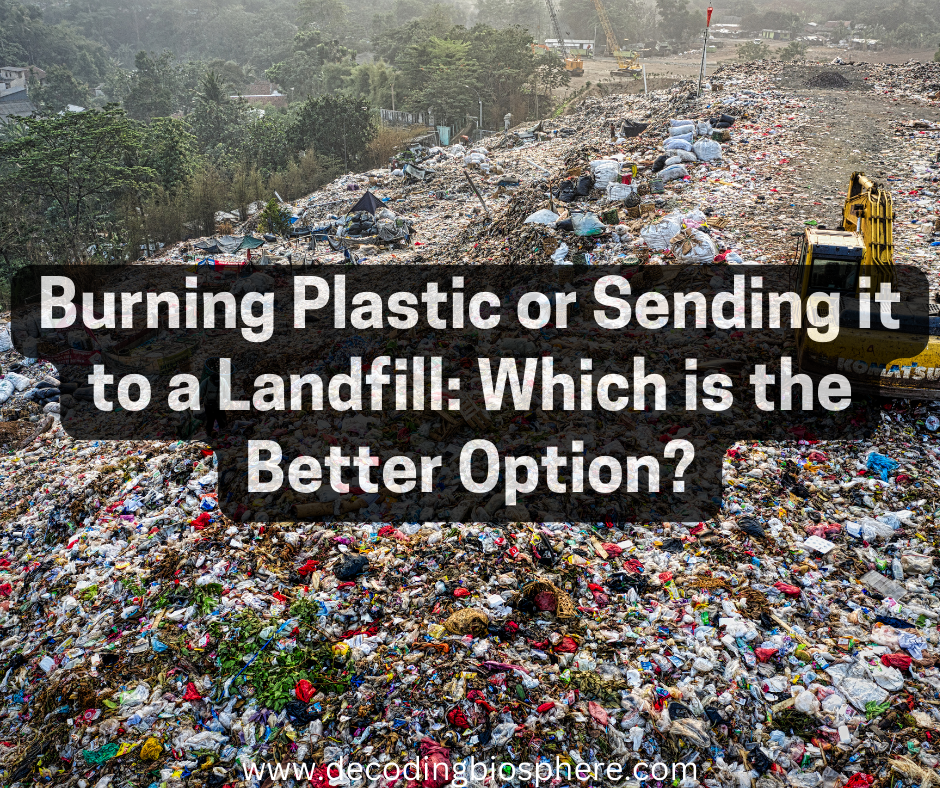Plastic, we see it everywhere – in our homes, streets, and oceans. But what happens to all that plastic when we’re done with it? Some folks suggest burning it, while others say it’s better to chuck it in a landfill. Let’s break down these two options and figure out which is best for our planet.
The Environmental Impact of Burning Plastic
Burning plastic may seem like a convenient solution to getting rid of waste, but the environmental consequences are severe. When plastic is burned, it releases harmful chemicals and toxins into the air, contributing to air pollution and posing risks to human health. Among the most common pollutants emitted during the burning of plastic are dioxins, furans, and volatile organic compounds (VOCs). These pollutants can have serious health effects, including respiratory issues, cardiovascular problems, and even cancer.

Furthermore, burning plastic exacerbates climate change by releasing greenhouse gases such as carbon dioxide (CO2) and methane (CH4) into the atmosphere. These gases trap heat in the Earth’s atmosphere, leading to global warming and its associated impacts, such as rising sea levels, extreme weather events, and disruptions to ecosystems.
In addition to air pollution and climate change, burning plastic also contributes to the depletion of natural resources. Plastic is derived from fossil fuels, primarily petroleum and natural gas, which are finite resources that take millions of years to form. By burning plastic, we are not only wasting valuable resources but also perpetuating our dependence on fossil fuels and exacerbating environmental degradation.
The Environmental Impact of Landfilling Plastic
While sending plastic to a landfill may seem like a less harmful alternative to burning, it is far from an ideal solution. When plastic is disposed of in landfills, it can take hundreds or even thousands of years to decompose, depending on the type of plastic and environmental conditions. During this time, plastic waste can release harmful chemicals and pollutants into the soil and groundwater, contaminating ecosystems and posing risks to human health.

Moreover, landfills emit methane, a potent greenhouse gas that is even more harmful to the environment than CO2 in the short term. Methane is produced as organic matter, including plastic, decomposes in anaerobic (oxygen-deprived) conditions. Although modern landfills are equipped with systems to capture and control methane emissions, some methane still escapes into the atmosphere, contributing to climate change.
In addition to methane emissions, landfills also occupy valuable land space and can disrupt local ecosystems. As landfills expand to accommodate growing amounts of waste, they encroach upon natural habitats, degrade soil quality, and contribute to deforestation and loss of biodiversity. Furthermore, landfilling plastic perpetuates a linear “take-make-dispose” model of consumption that is unsustainable in the long run, as it fails to capture the value of materials through reuse, recycling, or recovery.
The Health Implications of Burning Plastic
In addition to its environmental impacts, burning plastic poses significant risks to public health. The emissions released during the combustion of plastic contain a cocktail of toxic substances, including dioxins, furans, heavy metals, and particulate matter. These pollutants can penetrate deep into the respiratory system, causing a range of health problems, from respiratory irritation and asthma to more serious conditions such as lung cancer and cardiovascular disease.
Children, the elderly, and individuals with pre-existing respiratory or cardiovascular conditions are particularly vulnerable to the health effects of burning plastic. Prolonged exposure to air pollution from burning plastic can exacerbate existing health conditions and increase the risk of developing new ones. Moreover, communities living near waste incineration facilities are disproportionately affected by air pollution and environmental injustice, as these facilities are often located in low-income neighborhoods and communities of color.
Furthermore, burning plastic releases microscopic plastic particles known as microplastics into the air, soil, and water. These microplastics can be inhaled, ingested, or absorbed through the skin, posing potential health risks to humans and wildlife. Although the long-term health effects of microplastic exposure are still being studied, preliminary research suggests that it may disrupt hormone levels, weaken the immune system, and accumulate in vital organs.
The Health Implications of Landfilling Plastic
While landfilling plastic may not pose the immediate health risks associated with burning, it still has significant public health implications. As plastic waste decomposes in landfills, it releases a variety of chemicals and pollutants into the surrounding environment, including leachate, which is a toxic liquid that forms as water percolates through the landfill waste.
Leachate contains a complex mixture of organic and inorganic compounds, including heavy metals, volatile organic compounds (VOCs), and pathogens, which can contaminate groundwater and surface water sources. Exposure to contaminated water can lead to a range of health problems, including gastrointestinal illnesses, neurological disorders, and reproductive issues.
Moreover, landfill sites attract pests such as rats, flies, and mosquitoes, which can carry diseases and pose additional health risks to nearby communities. Inadequate waste management practices at landfill sites, such as improper covering and maintenance, can exacerbate these health hazards and increase the likelihood of environmental contamination.
Furthermore, the accumulation of plastic waste in landfills can create breeding grounds for disease vectors and contribute to the spread of infectious diseases. As plastic waste decomposes, it provides nutrients and shelter for bacteria, viruses, and other pathogens, which can thrive in the warm, moist environment of a landfill site. In areas with poor sanitation and waste management infrastructure, the risk of disease transmission from landfill sites is particularly high, posing a threat to public health and well-being.
The Economic Costs of Burning Plastic
In addition to its environmental and health impacts, burning plastic also carries significant economic costs. The combustion of plastic generates air pollution and greenhouse gas emissions, which impose indirect costs on society in the form of healthcare expenses, property damage, and lost productivity. According to the World Health Organization (WHO), air pollution is responsible for an estimated 7 million premature deaths worldwide each year, with the associated economic costs totaling trillions of dollars.
Furthermore, burning plastic contributes to climate change, which has far-reaching economic consequences, including damage to infrastructure, disruptions to agriculture and food supply chains, and increased frequency and severity of natural disasters. The economic costs of climate change are projected to escalate in the coming decades, posing a significant threat to global prosperity and stability.
Moreover, the disposal of plastic waste through incineration incurs direct costs for municipalities and waste management companies, including the construction and operation of incineration facilities, as well as the disposal of ash and other byproducts. These costs can be substantial, particularly in regions with limited resources and infrastructure for waste management.
Furthermore, the reliance on incineration as a disposal method for plastic waste perpetuates a linear “take-make-dispose” model of consumption that is economically unsustainable in the long term. Instead of capturing the economic value of materials through reuse, recycling, or recovery, incineration squanders valuable resources and perpetuates our dependence on finite fossil fuels.
The Economic Costs of Landfilling Plastic
Similarly, landfilling plastic waste carries significant economic costs, both direct and indirect. The operation and maintenance of landfill sites require substantial financial investment, including the acquisition of land, construction of infrastructure, and implementation of environmental monitoring and remediation measures. Furthermore, landfilling incurs ongoing costs for waste management companies, including the collection, transportation, and disposal of waste.
Moreover, the environmental impacts of landfilling plastic, such as groundwater contamination, soil degradation, and air pollution, impose indirect costs on society in the form of healthcare expenses, environmental remediation efforts, and loss of ecosystem services. These costs are often borne by taxpayers, local communities, and future generations, rather than the producers and consumers responsible for generating the waste.
Furthermore, the disposal of plastic waste in landfills perpetuates a linear “take-make-dispose” model of consumption that fails to capture the economic value of materials through reuse, recycling, or recovery. Instead of incentivizing resource conservation and circular economy principles, landfilling encourages wasteful consumption patterns and exacerbates environmental degradation.
The Role of Recycling in Plastic Waste Management
Amidst the debate over burning plastic versus landfilling, recycling emerges as a promising alternative that can mitigate the environmental, health, and economic impacts of plastic waste. Recycling involves collecting, sorting, and processing plastic waste to produce new products, thereby extending the lifecycle of materials and reducing the need for virgin resources.
By diverting plastic waste from incineration and landfilling, recycling conserves valuable natural resources, reduces energy consumption, and minimizes greenhouse gas emissions. According to the Environmental Protection Agency (EPA), recycling one ton of plastic saves approximately 3.8 barrels of oil and reduces greenhouse gas emissions by an equivalent of 1.5 metric tons of CO2.
Moreover, recycling creates economic opportunities by generating jobs, stimulating local economies, and fostering innovation in waste management and resource recovery technologies. According to the Recycling Economic Development Advocacy Research (REDAR) Group, recycling supports over 750,000 jobs and generates over $110 billion in economic output annually in the United States alone.
Furthermore, recycling reduces the environmental and health risks associated with burning and landfilling plastic by diverting waste from disposal sites and preventing the release of harmful pollutants into the air, soil, and water. By closing the loop on plastic production and consumption, recycling promotes a circular economy model that values resource conservation, waste reduction, and sustainable development.
Challenges and Opportunities in Plastic Waste Management
Despite its numerous benefits, recycling faces several challenges and barriers that hinder its widespread adoption and effectiveness. These challenges include inadequate infrastructure and technology for waste collection and sorting, limited market demand for recycled materials, and low public awareness and participation in recycling programs.
Furthermore, the global plastic recycling rate remains low, with only a fraction of plastic waste being recycled each year. According to the Ellen MacArthur Foundation, less than 10% of plastic produced worldwide is recycled, while the majority ends up in landfills, incinerators, or the natural environment.
However, there are opportunities to overcome these challenges and improve plastic waste management practices through collaboration, innovation, and policy intervention. Governments, businesses, and civil society organizations can work together to invest in infrastructure and technology for waste collection, sorting, and recycling, as well as to promote sustainable consumption and production patterns.
Furthermore, policies and regulations can play a crucial role in incentivizing recycling and reducing plastic pollution. Governments can implement extended producer responsibility (EPR) schemes, deposit return systems (DRS), and landfill taxes to encourage producers and consumers to reduce, reuse, and recycle plastic waste. Moreover, public awareness campaigns and education initiatives can raise awareness about the environmental and health impacts of plastic pollution and promote behavior change towards more sustainable practices.
Conclusion
In conclusion, the debate over burning plastic versus sending it to a landfill is complex and multifaceted, with significant environmental, health, and economic implications. While both options have drawbacks, recycling emerges as a promising alternative that can mitigate the negative impacts of plastic waste and promote a more sustainable approach to consumption and waste management.
By diverting plastic waste from disposal sites, recycling conserves valuable resources, reduces greenhouse gas emissions, and minimizes environmental pollution. Moreover, recycling creates economic opportunities, generates jobs, and stimulates innovation in waste management and resource recovery technologies.
You May Also Like

